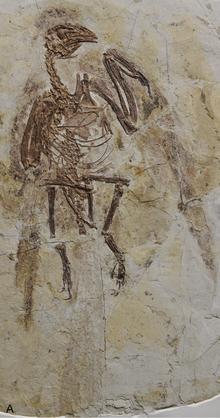Pengornithidae
| Pengornithids | |
|---|---|

| |
| Fossil specimen of Parapengornis eurycaudatus
| |
| Scientific classification | |
| Domain: | Eukaryota |
| Kingdom: | Animalia |
| Phylum: | Chordata |
| Clade: | Dinosauria |
| Clade: | Saurischia |
| Clade: | Theropoda |
| Clade: | Avialae |
| Clade: | †Enantiornithes |
| Family: | †Pengornithidae Wang et al., 2014 |
| Type genus | |
| †Pengornis Zhou, Clarke, & Zhang, 2008
| |
| Genera | |
Pengornithidae is a group of early
Description
Pengornithids were basal enantiornithes. They had many small teeth in their jaws, and stout legs. Their internal anatomy was characterized by a hooked outgrowth of the shoulder blade and a pygostyle (the tail bone to which long feathers attach) which was short and rounded, instead of long and blade-shaped as in other enantiornithes. While most enantiornithes had four long backward projections growing from their breastbones, pengornithids only had two.[5]
Assuming Falcatakely is a pengornithid, it exhibits a rather novel cranial morphology compared to other enantiornitheans, having a toucan-like snout ending on small teeth.
Ecology
The unique, rounded pygostyle and long, stiff tail feathers of pengornithids would have made their tail overall similar to that of woodpeckers. The feet of pengornithids were also particularly adapted for grasping branches. These features indicate that while pengornithids may not have been as adept at climbing as many modern birds, they were better climbers than many other enantiornithes.[5]
Falcatakely has been compared to
Classification
The cladogram below was found in the phylogenetic analysis of Hu et al. 2014.[5]
| Enantiornithes |
| ||||||||||||||||||
The cladogram below was found by an analysis by Wang et al. in 2015, updated from a previous data set created by Jingmai O'Connor.[6]
| Ornithothoraces |
| ||||||||||||||||||
